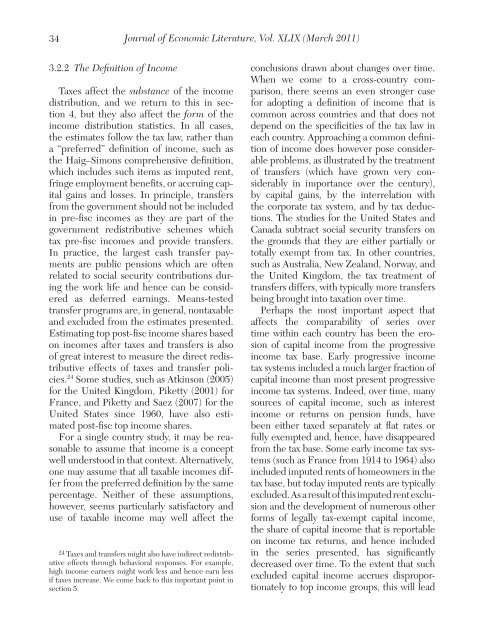34Journal <strong>of</strong> Economic Literature, Vol. XLIX (March 2011)3.2.2 The Def<strong>in</strong>ition <strong>of</strong> IncomeTaxes affect <strong>the</strong> substance <strong>of</strong> <strong>the</strong> <strong>in</strong>comedistribution, <strong>and</strong> we return to this <strong>in</strong> section4, but <strong>the</strong>y also affect <strong>the</strong> form <strong>of</strong> <strong>the</strong><strong>in</strong>come distribution statistics. In all cases,<strong>the</strong> estimates follow <strong>the</strong> tax law, ra<strong>the</strong>r thana “preferred” def<strong>in</strong>ition <strong>of</strong> <strong>in</strong>come, such as<strong>the</strong> Haig–Simons comprehensive def<strong>in</strong>ition,which <strong>in</strong>cludes such items as imputed rent,fr<strong>in</strong>ge employment benefits, or accru<strong>in</strong>g capitalga<strong>in</strong>s <strong>and</strong> losses. In pr<strong>in</strong>ciple, transfersfrom <strong>the</strong> government should not be <strong>in</strong>cluded<strong>in</strong> pre-fisc <strong>in</strong>comes as <strong>the</strong>y are part <strong>of</strong> <strong>the</strong>government redistributive schemes whichtax pre-fisc <strong>in</strong>comes <strong>and</strong> provide transfers.In practice, <strong>the</strong> largest cash transfer paymentsare public pensions which are <strong>of</strong>tenrelated to social security contributions dur<strong>in</strong>g<strong>the</strong> work life <strong>and</strong> hence can be consideredas deferred earn<strong>in</strong>gs. Means-testedtransfer programs are, <strong>in</strong> general, nontaxable<strong>and</strong> excluded from <strong>the</strong> estimates presented.Estimat<strong>in</strong>g top post-fisc <strong>in</strong>come shares basedon <strong>in</strong>comes after taxes <strong>and</strong> transfers is also<strong>of</strong> great <strong>in</strong>terest to measure <strong>the</strong> direct redistributiveeffects <strong>of</strong> taxes <strong>and</strong> transfer policies.24 Some studies, such as Atk<strong>in</strong>son (2005)for <strong>the</strong> United K<strong>in</strong>gdom, Piketty (2001) forFrance, <strong>and</strong> Piketty <strong>and</strong> Saez (2007) for <strong>the</strong>United States s<strong>in</strong>ce 1960, have also estimatedpost-fisc top <strong>in</strong>come shares.For a s<strong>in</strong>gle country study, it may be reasonableto assume that <strong>in</strong>come is a conceptwell understood <strong>in</strong> that context. Alternatively,one may assume that all taxable <strong>in</strong>comes differfrom <strong>the</strong> preferred def<strong>in</strong>ition by <strong>the</strong> samepercentage. Nei<strong>the</strong>r <strong>of</strong> <strong>the</strong>se assumptions,however, seems particularly satisfactory <strong>and</strong>use <strong>of</strong> taxable <strong>in</strong>come may well affect <strong>the</strong>24 Taxes <strong>and</strong> transfers might also have <strong>in</strong>direct redistributiveeffects through behavioral responses. For example,high <strong>in</strong>come earners might work less <strong>and</strong> hence earn lessif taxes <strong>in</strong>crease. We come back to this important po<strong>in</strong>t <strong>in</strong>section 5.conclusions drawn about changes over time.When we come to a cross-country comparison,<strong>the</strong>re seems an even stronger casefor adopt<strong>in</strong>g a def<strong>in</strong>ition <strong>of</strong> <strong>in</strong>come that iscommon across countries <strong>and</strong> that does notdepend on <strong>the</strong> specificities <strong>of</strong> <strong>the</strong> tax law <strong>in</strong>each country. Approach<strong>in</strong>g a common def<strong>in</strong>ition<strong>of</strong> <strong>in</strong>come does however pose considerableproblems, as illustrated by <strong>the</strong> treatment<strong>of</strong> transfers (which have grown very considerably<strong>in</strong> importance over <strong>the</strong> century),by capital ga<strong>in</strong>s, by <strong>the</strong> <strong>in</strong>terrelation <strong>with</strong><strong>the</strong> corporate tax system, <strong>and</strong> by tax deductions.The studies for <strong>the</strong> United States <strong>and</strong>Canada subtract social security transfers on<strong>the</strong> grounds that <strong>the</strong>y are ei<strong>the</strong>r partially ortotally exempt from tax. In o<strong>the</strong>r countries,such as Australia, New Zeal<strong>and</strong>, Norway, <strong>and</strong><strong>the</strong> United K<strong>in</strong>gdom, <strong>the</strong> tax treatment <strong>of</strong>transfers differs, <strong>with</strong> typically more transfersbe<strong>in</strong>g brought <strong>in</strong>to taxation over time.Perhaps <strong>the</strong> most important aspect thataffects <strong>the</strong> comparability <strong>of</strong> series overtime <strong>with</strong><strong>in</strong> each country has been <strong>the</strong> erosion<strong>of</strong> capital <strong>in</strong>come from <strong>the</strong> progressive<strong>in</strong>come tax base. Early progressive <strong>in</strong>cometax systems <strong>in</strong>cluded a much larger fraction <strong>of</strong>capital <strong>in</strong>come than most present pro gressive<strong>in</strong>come tax systems. Indeed, over time, manysources <strong>of</strong> capital <strong>in</strong>come, such as <strong>in</strong>terest<strong>in</strong>come or returns on pension funds, havebeen ei<strong>the</strong>r taxed separately at flat rates orfully exempted <strong>and</strong>, hence, have disappearedfrom <strong>the</strong> tax base. Some early <strong>in</strong>come tax systems(such as France from 1914 to 1964) also<strong>in</strong>cluded imputed rents <strong>of</strong> homeowners <strong>in</strong> <strong>the</strong>tax base, but today imputed rents are typicallyexcluded. As a result <strong>of</strong> this imputed rent exclusion<strong>and</strong> <strong>the</strong> development <strong>of</strong> numerous o<strong>the</strong>rforms <strong>of</strong> legally tax-exempt capital <strong>in</strong>come,<strong>the</strong> share <strong>of</strong> capital <strong>in</strong>come that is reportableon <strong>in</strong>come tax returns, <strong>and</strong> hence <strong>in</strong>cluded<strong>in</strong> <strong>the</strong> series presented, has significantlydecreased over time. To <strong>the</strong> extent that suchexcluded capital <strong>in</strong>come accrues disproportionatelyto top <strong>in</strong>come groups, this will lead
Atk<strong>in</strong>son, Piketty, <strong>and</strong> Saez: <strong>Top</strong> <strong>Incomes</strong> <strong>in</strong> <strong>the</strong> <strong>Long</strong> <strong>Run</strong> <strong>of</strong> History35to an underestimation <strong>of</strong> top <strong>in</strong>come shares.Ideally, one would want to impute excludedcapital <strong>in</strong>come back to each <strong>in</strong>come group.Because <strong>of</strong> lack <strong>of</strong> data, such an imputationis very difficult to fully carry out. 25 Some <strong>of</strong><strong>the</strong> studies discuss whe<strong>the</strong>r <strong>the</strong> exclusion <strong>of</strong>capital <strong>in</strong>come affects <strong>the</strong> series. For example,Chiaki Moriguchi <strong>and</strong> Saez (2008), <strong>in</strong> <strong>the</strong>case <strong>of</strong> Japan, use survey data to estimate how<strong>in</strong>terest <strong>in</strong>come—today almost completelyexcluded from <strong>the</strong> comprehensive <strong>in</strong>come taxbase <strong>in</strong> Japan—is distributed across <strong>in</strong>comegroups. In <strong>the</strong> case <strong>of</strong> France, Piketty (2001,2003) has shown that <strong>the</strong> long-run decl<strong>in</strong>e <strong>of</strong>top <strong>in</strong>come shares was robust <strong>in</strong> <strong>the</strong> sense thateven an upper bound imputation <strong>of</strong> today’stax-exempt capital <strong>in</strong>comes to today’s reportedtop <strong>in</strong>comes would be largely <strong>in</strong>sufficient toundo <strong>the</strong> observed fall. In <strong>the</strong> estimates <strong>of</strong>top shares for Norway (Rolf Aaberge <strong>and</strong>Atk<strong>in</strong>son 2010), a calculation has been made<strong>of</strong> <strong>in</strong>come <strong>in</strong>clud<strong>in</strong>g <strong>the</strong> “full” return to stocks,but no systematic attempt has been made toimpute full capital <strong>in</strong>come on a comparablebasis over time <strong>and</strong> across countries. We viewthis as one <strong>of</strong> <strong>the</strong> ma<strong>in</strong> shortcom<strong>in</strong>gs—probably<strong>the</strong> ma<strong>in</strong> shortcom<strong>in</strong>g—<strong>of</strong> our data set.As we shall see <strong>in</strong> sections below, this limits<strong>the</strong> extent to which one can use our data setto rigorously test <strong>the</strong> <strong>the</strong>oretical economicmechanisms at play.The treatment <strong>of</strong> capital ga<strong>in</strong>s <strong>and</strong> lossesalso differs across time <strong>and</strong> across countries.For a number <strong>of</strong> countries, series both <strong>in</strong>clud<strong>in</strong>g<strong>and</strong> exclud<strong>in</strong>g capital ga<strong>in</strong>s have beenproduced (see table 4). As shown <strong>in</strong> figure 7,<strong>the</strong> effects <strong>of</strong> <strong>the</strong> <strong>in</strong>clusion <strong>of</strong> capital ga<strong>in</strong>son <strong>the</strong> share <strong>of</strong> <strong>the</strong> top percentile is <strong>of</strong>tensubstantial. In <strong>the</strong> case <strong>of</strong> Sweden, JesperRo<strong>in</strong>e <strong>and</strong> Daniel Waldenström (2008) notethat “over <strong>the</strong> past two decades <strong>the</strong> generalpicture turns out to depend crucially on25 Wolff <strong>and</strong> Zacharias (2009) use <strong>the</strong> Survey <strong>of</strong>Consumer F<strong>in</strong>ance <strong>and</strong> comb<strong>in</strong>e <strong>in</strong>come <strong>and</strong> wealth datato estimate broader measures <strong>of</strong> capital <strong>in</strong>come s<strong>in</strong>ce 1982.how <strong>in</strong>come from capital ga<strong>in</strong>s is treated.If we <strong>in</strong>clude capital ga<strong>in</strong>s, Swedish <strong>in</strong>come<strong>in</strong>equality has <strong>in</strong>creased quite substantially;when exclud<strong>in</strong>g <strong>the</strong>m, top <strong>in</strong>come shareshave <strong>in</strong>creased much less.” In all cases, onlyrealized capital ga<strong>in</strong>s are <strong>in</strong>cluded, if at all,<strong>in</strong> tax statistics <strong>and</strong> no <strong>in</strong>formation on accru<strong>in</strong>gcapital ga<strong>in</strong>s is available. Some accruedcapital ga<strong>in</strong>s are never realized, for example,when <strong>the</strong>re are step-up <strong>of</strong> basis provisions attime <strong>of</strong> death as <strong>in</strong> <strong>the</strong> United States. 26F<strong>in</strong>ally, although <strong>the</strong> dist<strong>in</strong>ction betweencapital <strong>and</strong> labor <strong>in</strong>come is clear conceptually,it is <strong>of</strong>ten partly blurred <strong>in</strong> <strong>the</strong> compositionaltax statistics. For example, realizedcapital ga<strong>in</strong>s <strong>of</strong> bus<strong>in</strong>ess owners <strong>of</strong>ten correspondto <strong>the</strong> sale <strong>of</strong> accumulated earn<strong>in</strong>gs<strong>of</strong> entrepreneurs <strong>in</strong> <strong>the</strong>ir firm, ra<strong>the</strong>r thanreturn on capital. Stock-option compensationsometimes appears as wage <strong>in</strong>come butsometimes as capital <strong>in</strong>come <strong>in</strong> tax statisticsdepend<strong>in</strong>g on <strong>the</strong> tax law.Income tax systems differ <strong>in</strong> <strong>the</strong> extent<strong>of</strong> <strong>the</strong>ir provisions allow<strong>in</strong>g <strong>the</strong> deduction<strong>of</strong> such items as <strong>in</strong>terest paid, depreciation,pension contributions, alimony payments,<strong>and</strong> charitable contributions. Income fromwhich <strong>the</strong>se deductions have been subtractedis <strong>of</strong>ten referred to as “net <strong>in</strong>come.” (We arenot referr<strong>in</strong>g here to personal exemptions.)The aim is <strong>in</strong> general to measure gross<strong>in</strong>come before deductions, but this is notalways possible. The French estimates show<strong>in</strong>come after deduct<strong>in</strong>g employee socialsecurity contributions. In a number <strong>of</strong> countries,<strong>the</strong> earlier <strong>in</strong>come tax distributionsrefer to <strong>in</strong>come after <strong>the</strong>se deductions, but<strong>the</strong> later distributions refer to gross <strong>in</strong>come.In <strong>the</strong> United States, <strong>the</strong> <strong>in</strong>come tax returnsprior to 1944 showed <strong>the</strong> distribution by26 Us<strong>in</strong>g <strong>the</strong> Survey <strong>of</strong> Consumer F<strong>in</strong>ances, Poterba<strong>and</strong> Scott Weisbenner (2001) estimate that, <strong>in</strong> 1998, capitalga<strong>in</strong>s unrealized at time <strong>of</strong> death were $42.8bn (table 10-8,p. 440), i.e., slightly less than 10 percent <strong>of</strong> <strong>the</strong> $440bn <strong>of</strong>net realized capital ga<strong>in</strong>s reported on <strong>in</strong>dividual tax returns<strong>in</strong> 1998 (Piketty <strong>and</strong> Saez 2003).
- Page 5 and 6: Atkinson, Piketty, and Saez: Top In
- Page 7 and 8: Atkinson, Piketty, and Saez: Top In
- Page 9 and 10: Atkinson, Piketty, and Saez: Top In
- Page 11 and 12: Atkinson, Piketty, and Saez: Top In
- Page 13 and 14: Atkinson, Piketty, and Saez: Top In
- Page 15 and 16: Atkinson, Piketty, and Saez: Top In
- Page 17 and 18: Atkinson, Piketty, and Saez: Top In
- Page 19 and 20: Atkinson, Piketty, and Saez: Top In
- Page 21 and 22: Atkinson, Piketty, and Saez: Top In
- Page 23 and 24: Atkinson, Piketty, and Saez: Top In
- Page 25 and 26: Atkinson, Piketty, and Saez: Top In
- Page 27 and 28: Atkinson, Piketty, and Saez: Top In
- Page 29 and 30: Atkinson, Piketty, and Saez: Top In
- Page 31: Atkinson, Piketty, and Saez: Top In
- Page 35 and 36: Atkinson, Piketty, and Saez: Top In
- Page 37 and 38: Atkinson, Piketty, and Saez: Top In
- Page 39 and 40: Atkinson, Piketty, and Saez: Top In
- Page 41 and 42: Atkinson, Piketty, and Saez: Top In
- Page 43 and 44: Atkinson, Piketty, and Saez: Top In
- Page 45 and 46: Atkinson, Piketty, and Saez: Top In
- Page 47 and 48: Atkinson, Piketty, and Saez: Top In
- Page 49 and 50: Atkinson, Piketty, and Saez: Top In
- Page 51 and 52: Atkinson, Piketty, and Saez: Top In
- Page 53 and 54: Atkinson, Piketty, and Saez: Top In
- Page 55 and 56: Atkinson, Piketty, and Saez: Top In
- Page 57 and 58: Atkinson, Piketty, and Saez: Top In
- Page 59 and 60: Atkinson, Piketty, and Saez: Top In
- Page 61 and 62: Atkinson, Piketty, and Saez: Top In
- Page 63 and 64: Atkinson, Piketty, and Saez: Top In
- Page 65 and 66: Atkinson, Piketty, and Saez: Top In
- Page 67 and 68: Atkinson, Piketty, and Saez: Top In
- Page 69: Atkinson, Piketty, and Saez: Top In















